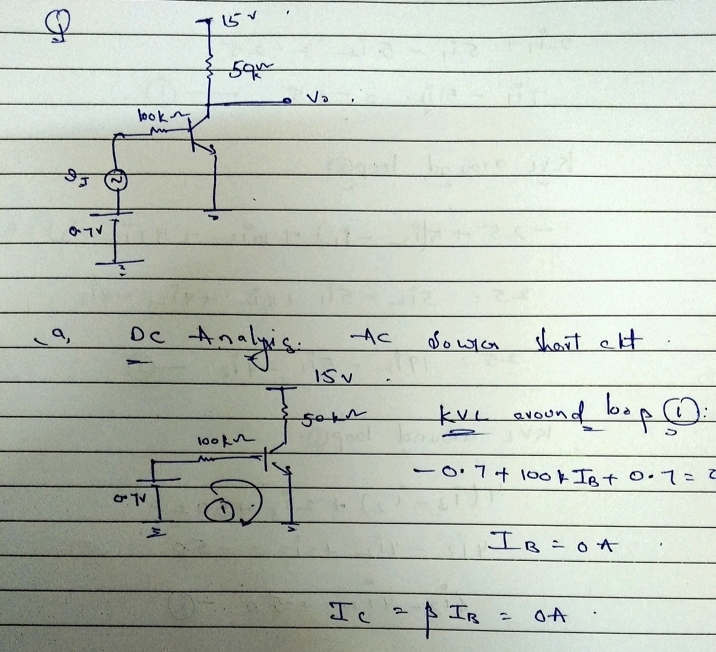Consider the common emitter BJT amplifier shown in Figure 3.1. The input voltage v1 comprises the sum of a DC bias voltage V₁ = 0.7V and a sinusoid of the form v₁ = A sin wt, where A = 0.001V. For the values shown, you may assume that A is very small compared to V₁. You may further assume that the BJT always operates in its active region. Figure 3.2 shows a small signal model for the BJT operating in its active region. Let the output voltage vo comprise a DC bias term Vo and a small-signal response term Vo. BiB VBE (a) BJT iE E 100 ΚΩ 0.001 V sin(cor) w VCE 0.7 V Figure 3.1 Figure 3.2 15 V 50 ΚΩ Vo B = 100 Bib Bib E (b) BJT small signal model a) Determine the output operating point voltage Vo for the input bias of V₁ = 0.7V. b) Draw the small signal equivalent circuit for the amplifier. c) Determine the small signal gain of the amplifier. d) What is the value of vo, the small signal component of the output, given the small signal input shown in Figure 3.1.
Consider the common emitter BJT amplifier shown in Figure 3.1. The input voltage v1 comprises the sum of a DC bias voltage V₁ = 0.7V and a sinusoid of the form v₁ = A sin wt, where A = 0.001V. For the values shown, you may assume that A is very small compared to V₁. You may further assume that the BJT always operates in its active region. Figure 3.2 shows a small signal model for the BJT operating in its active region. Let the output voltage vo comprise a DC bias term Vo and a small-signal response term Vo. BiB VBE (a) BJT iE E 100 ΚΩ 0.001 V sin(cor) w VCE 0.7 V Figure 3.1 Figure 3.2 15 V 50 ΚΩ Vo B = 100 Bib Bib E (b) BJT small signal model a) Determine the output operating point voltage Vo for the input bias of V₁ = 0.7V. b) Draw the small signal equivalent circuit for the amplifier. c) Determine the small signal gain of the amplifier. d) What is the value of vo, the small signal component of the output, given the small signal input shown in Figure 3.1.
Introductory Circuit Analysis (13th Edition)
13th Edition
ISBN:9780133923605
Author:Robert L. Boylestad
Publisher:Robert L. Boylestad
Chapter1: Introduction
Section: Chapter Questions
Problem 1P: Visit your local library (at school or home) and describe the extent to which it provides literature...
Related questions
Question

Transcribed Image Text:Consider the common emitter BJT amplifier shown in Figure 3.1. The input
voltage v1 comprises the sum of a DC bias voltage V₁ = 0.7V and a sinusoid of the form
v₁ = A sin wt, where A = 0.001V. For the values shown, you may assume that A is very
small compared to V₁. You may further assume that the BJT always operates in its active
region. Figure 3.2 shows a small signal model for the BJT operating in its active region.
Let the output voltage vo comprise a DC bias term Vo and a small-signal response term
Vo.
B iB
VBE
(a) BJT
¹E
E
0.001 V sin(cor)
VCE
0.7 V
Figure 3.1
www
Figure 3.2
15 V
100 ΚΩ
wwwB 100
50 ΚΩ
vo
B ib
Bib
E
(b) BJT small signal model
a) Determine the output operating point voltage Vo for the input bias of V₁ = 0.7V.
b) Draw the small signal equivalent circuit for the amplifier.
c) Determine the small signal gain of the amplifier.
d) What is the value of vo, the small signal component of the output, given the small
signal input shown in Figure 3.1.
Expert Solution
Step 1

Trending now
This is a popular solution!
Step by step
Solved in 2 steps with 2 images

Knowledge Booster
Learn more about
Need a deep-dive on the concept behind this application? Look no further. Learn more about this topic, electrical-engineering and related others by exploring similar questions and additional content below.Recommended textbooks for you

Introductory Circuit Analysis (13th Edition)
Electrical Engineering
ISBN:
9780133923605
Author:
Robert L. Boylestad
Publisher:
PEARSON

Delmar's Standard Textbook Of Electricity
Electrical Engineering
ISBN:
9781337900348
Author:
Stephen L. Herman
Publisher:
Cengage Learning

Programmable Logic Controllers
Electrical Engineering
ISBN:
9780073373843
Author:
Frank D. Petruzella
Publisher:
McGraw-Hill Education

Introductory Circuit Analysis (13th Edition)
Electrical Engineering
ISBN:
9780133923605
Author:
Robert L. Boylestad
Publisher:
PEARSON

Delmar's Standard Textbook Of Electricity
Electrical Engineering
ISBN:
9781337900348
Author:
Stephen L. Herman
Publisher:
Cengage Learning

Programmable Logic Controllers
Electrical Engineering
ISBN:
9780073373843
Author:
Frank D. Petruzella
Publisher:
McGraw-Hill Education

Fundamentals of Electric Circuits
Electrical Engineering
ISBN:
9780078028229
Author:
Charles K Alexander, Matthew Sadiku
Publisher:
McGraw-Hill Education

Electric Circuits. (11th Edition)
Electrical Engineering
ISBN:
9780134746968
Author:
James W. Nilsson, Susan Riedel
Publisher:
PEARSON

Engineering Electromagnetics
Electrical Engineering
ISBN:
9780078028151
Author:
Hayt, William H. (william Hart), Jr, BUCK, John A.
Publisher:
Mcgraw-hill Education,